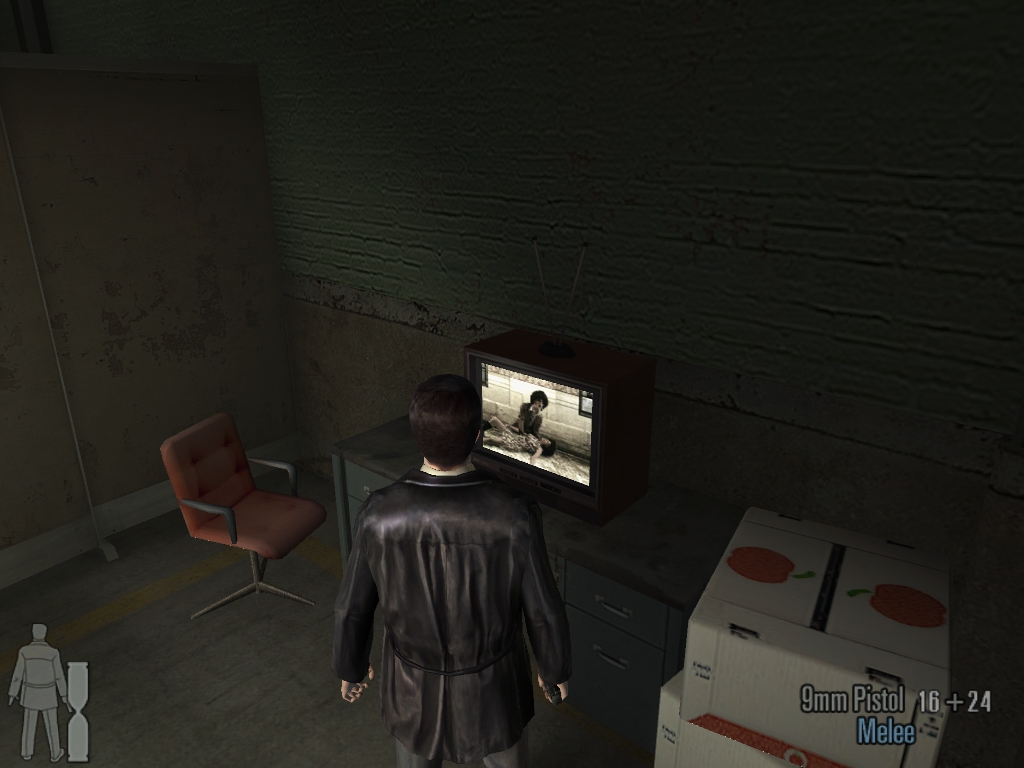
Max Payne 2: The Fall of Max Payne
Written by: Rik
Date posted: November 19, 2008
- Genre: Action
- Developed by: Remedy
- Published by: Rockstar
- Year released: 2003
- Our score: 9
The original Max Payne was a triumph, combining thrilling bullet-ridden action sequences with a consistently-entertaining story narrated by a gravelly-voiced protagonist. Despite a lengthy development and unashamedly one-dimensional gameplay, the voices of a handful of grumpy gaming naysayers were largely drowned out by a generally favourable reception, with enough people liking (and buying) the game to ensure the speedy development and release of a sequel.
While a logical – and, considering our overwhelmingly positive verdict on the first game, welcome – decision, from a writing and development point of view, setting up the return of Max Payne can’t have been straightforward. As anyone who’s finished the first game (and if you haven’t, your time would clearly be better spent doing that than potentially spoiling your enjoyment of it by reading this) will know, though Max ultimately comes out of his one-man war against anyone and everyone with his life, the ending didn’t exactly scream ‘SEQUEL!’ either. Having shot his way through a million bad guys to finally get to those responsible for killing his wife and baby, Max’s story, it seemed, was over.
But, as our protagonist succinctly puts it, “I was still alive, my loved ones were still dead. It wasn’t over.” Max Payne 2 sees our hero struggling through life, deprived of the clarity of being driven by revenge. Some two years after the events of the first game, Max has left the DEA and returned to the NYPD as a homicide detective. The fact that everyone in the city in possession of a firearm is no longer gunning for him is of little consolation, and like many ‘cops with issues’, Max has taken to living in a scummy apartment, drinking heavily, sleeping on the sofa and calling telephone sex lines (no, really). In short, he’s a broken man.
Anyway, in between all of the depression, microwave meals-for-one and disturbing hallucinatory nightmares (see Is This the Payne Residence?), Max has some actual police work to do, and in the course of his investigations he comes across a murderous gang who disguise themselves as cleaners. More significantly, he runs into Mona Sax, sometime friend/enemy (these things are complicated) from the first game. To say much more would probably be to spoil things, but given that Ms. Sax appears prominently on the game’s box art, it’s probably not too controversial to reveal that she plays a major part in the game (for more, see A Damsel in Distress).
That Max shares the limelight with another character represents a significant departure from last time around. Other non-player characters are more prominent, too, from Max’s police colleagues Jim Bravura and Jeanette Winterson to mafia-men Vinnie Gognitti and Vladimir Lem, as well as a handful of other incidental characters with whom you can actually converse rather than just plough a couple of shotgun shells into their torso. Okay, it’s still hardly Deus Ex but it’s virtually an ensemble piece when compared with the original.
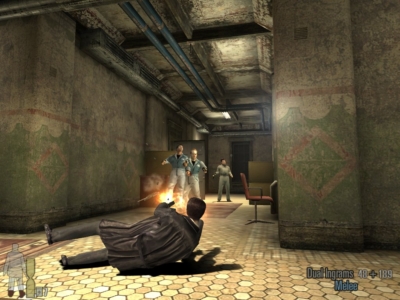
After performing a shootdodge, you can now continue firing once you’re on the ground, which always comes in handy.
Still, although the early pace of the game is more considered than before, it’s certainly not long before things get messy and Max finds himself confronted with problems that are best resolved by shooting a whole lot of people. The gameplay has been refined slightly, but it’s still largely reliant on slowing down time, diving about, and generally causing mayhem and destruction. The bullet-time system has been tweaked to make it slightly more forgiving, with your meter regenerating over time rather than getting a boost from killing enemies, and performing a shootdodge (ie a ridiculous, often horizontal, slow-motion dive while firing at an enemy) no longer draws from your reserves.
Going into bullet-time mode also produces a blurry, drunken graphical effect which is pretty cool, and at this point it seems appropriate to mention that the already amazing visuals of the first game have been improved upon here. Most prominently, the character models are much more impressive-looking, with the motionless, flat faces of old replaced by more detailed ones capable of lip-synching and presenting a handful of different expressions. This means more of the story can be presented via in-game cut-scenes rather than cutting back to the graphic novel each and every time there was some dialogue or plot-specific action. Fans of the graphic novel, fear not: it retains a significant part in the game, especially between levels and when Max launches into one of his rambling, darkly-muttered monologues – it’s just there are times when it makes sense to keep with the game engine, and fortunately most of the time Max Payne 2 makes the right choices.
While the first game delivered an almost faultless sequence of brutal, high-octane firefights, the action here is of an even higher calibre. The addition of Havok physics makes things more entertaining, with bodies, objects and general debris flying all over the place and bouncing off each other in a much more scientifically-accurate way than before. There’s an almost inexplicable amount of combustible material dotted around later levels, which doesn’t always make sense (why are there petrol cans everywhere?) but it does mean you can have some fun setting off explosions and giggling childishly as generic henchmen are launched into the air. It can also work against you, too, as I discovered after sending Max on an ill-advised sideways dive down a long staircase – while bullet-time and shootdodging may allow you to accomplish the implausible and near-impossible on many occasions, helping you to aim a gun while falling headfirst down some stairs is asking a little bit too much.
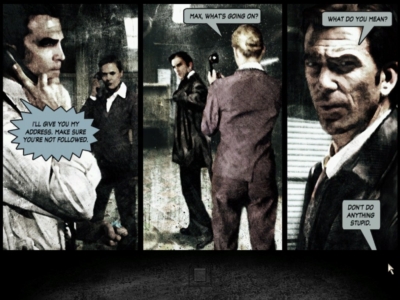
The graphic novel sequences are largely the same as in the first game, using a combination of real-life actors and computer-generated backgrounds.
If you’re generally in the pro-Payne camp, as I am, then it’s hard to find too many faults here. There are, however, times when Max Payne 2 doesn’t play to its strengths. For example, there are a few more ‘jumping’ sections this time around – not that there are any particularly taxing leaps required, but Max is no Lara Croft and can only attempt a rather stiff-looking hop which must end in him landing on his feet or else he (and you) will plunge to certain death. It’s no big deal, really, it just means you have to negotiate some fiddly bits using a rather clumsily-implemented feature. At other times, you’ll have incidental non-player characters fighting on your side, which is fair enough (especially as you don’t have to protect them) but observing them warping backwards up some stairs while following you takes a little bit of the gloss off an otherwise slickly-produced affair. They aren’t an especially impressive or important addition, which rather begs the question why Remedy bothered to include them in the first place.
The only other negative point I might allow myself to make is that, while the writers have done an admirable job in creating a whole new nightmare for Max to battle his way through, the plot of the original had an uncomplicated focus which was never likely to be replicated here. The relentlessness of the first game was powered by the immediacy of Max’s desire for answers, for closure, and to clear a path through anyone who tried to get in his way. Though this sequel is subtitled The Fall of Max Payne, in the last game he was smeared as a disgraced ex-cop, a murderer and on the run from the law (and everyone else) – haven’t we already seen this character sink to his lowest depths? To convince us otherwise requires a good deal of ambition and no little skill, and it’s a credit to Remedy that they almost pull it off. That’s not to say that the story here isn’t anything less than compelling, rather that if I had a sawn-off shotgun to my head and had to state a preference for one of the two, then I’d probably opt for the original.
Having said that, the ending of this one did make me feel a little bit sad. It could have been what actually happened during those climactic scenes; it might have been the fact that the game was over all too quickly (the only difficulty option available at the start is the easiest, ‘self-adjusting’ one on offer in the first game, and on this setting you should get it finished inside a weekend); or it could have been the realisation that (at the time of writing) there’s not likely to be a Max Payne 3 any time soon (despite promises during the credits that ‘Max Payne’s journey into the night will continue’). It was probably a combination of all three, it doesn’t really matter – but any game that can do that to you is pretty damn near essential in my book.
In summary, then: Max Payne – great. Max Payne 2 – also great. If, of course, you’ve already played the first one and decided you didn’t like it – too shallow, too linear, too cheesy, whatever – you won’t like this one either. It’s not for you, and that’s fine: you’ve already made up your mind, and let’s face it, no-one’s forcing you to play this one as well, so don’t go getting angry about it, okay? As for everyone else, well, I’m not sure what else I can say, except to once again advise you to give both of these games a go. If it helps you make up your mind, take a look at the whacking great score at the top of the page. Grey blobs mean good? Oh yes. [Edit: by which of course I mean, “A score of 9 is good? Oh yes.” Blobs are dead – we have numbers now].

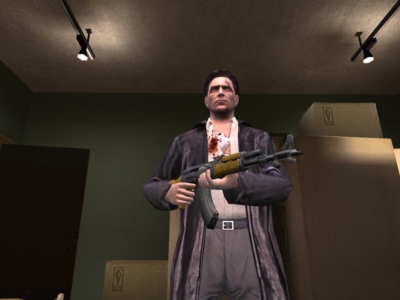
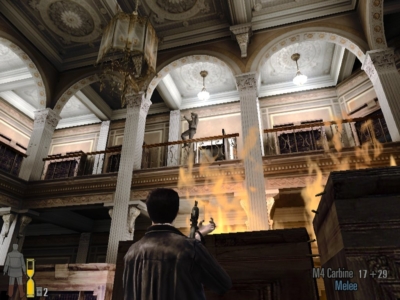

 Posts
Posts
I actually remember liking it less than the first one. Idk why, but I liked the way Max looked in the first game and the first game’s main music theme and emphasis on reds were much more likable to me. 2 is still a great game.
December 16, 2013 @ 3:22 am
I think the first one is still my favourite too. And, yes, to me the true Max Payne will always be a smirking Sam Lake!
December 16, 2013 @ 7:22 am
Just replayed it — we’re trapped at home because of our governement of (autocensored) and (even more autocensored) bozos. 🙁 Time to reread a few books, resee a few movies, and replay a few games. 😉
Same advice than when I first played it a few years ago. Pluses : prettier graphics engine, always too easy until the last two chapters where there’s suddenly a *little* challenge, excellent atmosphere set by a well-crafted “noirish” story, subtle “mise en abîme” and humour, pleasant voices, better looking nightmare sequences (still rather useless according to me). Small minuses : the change of the original actor, a few “fatal exception 0E” errors (on the same Win98SE system). A decent movie the player is the hero of. Note : as for Max Payne, never had to rely on slow motion bullet time. 😉
Still an A game, as the first one, though I think the second one is *slightly* better.
March 31, 2020 @ 4:48 pm